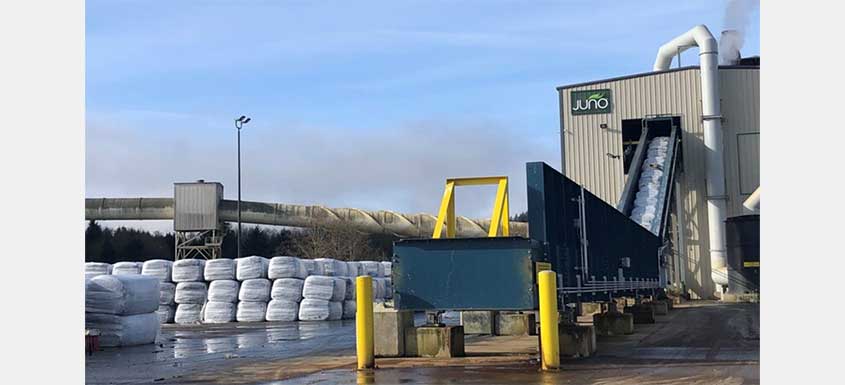About 146 million tons of municipal solid waste in the U.S. went to landfills in 2018, according to the Environmental Protection Agency (EPA). New technology is helping to turn some of that trash into treasure by recovering valuable materials for reuse.
T hat’s where Juno comes in. Georgia-Pacific's first commercial facility with its Juno technology is up and running in Toledo, Oregon.
hat’s where Juno comes in. Georgia-Pacific's first commercial facility with its Juno technology is up and running in Toledo, Oregon.
“Juno is a new innovative waste diversion and recycling process that captures recyclable material previously destined for landfill or incineration because of coatings or food contamination,” said John Mulcahy, Vice President – Stewardship for Georgia-Pacific.
Mulcahy said Juno works like a pressure cooker. Commercial waste comes into the Juno facility and enters the Juno™ Clave. This rotating pressurized vessel uses steam to sanitize and process the waste materials. Up to 90% of what is processed through Juno can be diverted from landfills.
Juno’s proprietary technology separates paper fibers, which are then used to make new paper products. Other recyclables are sorted for their markets. Food waste and leftover materials can be converted into biogas for a variety of renewable energy applications.
Paper is the most recycled material by weight. In 2021, the paper recycling rate was 68%. Still, about 23% of municipal solid waste is paper and paperboard, according to the EPA. Juno is trying to fix that.
“Diverting more reusable material from landfills and increasing recycling is a big step forward. It’s a win for people, communities, and the planet,” Mulcahy said.
Juno was born from the desire to capture more paper for recycling. A small team of innovators developed the idea for the technology behind Juno and saw an opportunity with commercial waste from places like airports, stadiums and office buildings. These places have a lot of paper-based waste that typically isn't recycled because of food contamination.
“Experimentation led to the development of our current patented process,” Mulcahy said. “A pilot unit was built in 2013 to test the technology. Hundreds of batches of waste were processed, and the resulting clean paper fiber was used to make new products.”
Since launching in 2021, Juno’s first commercial plant has increased landfill diversion. That means less trash is going to landfills in Toledo now that Juno is online.
Importantly, more recyclable material like paper is being recovered to make new products.
“The city of Toledo’s landfill diversion rate has increased nearly three-fold because of processing their waste through Juno,” Mulcahy said.
A benefit of Juno is that it complements existing waste collection systems. The Juno team hopes to see this technology expand in the U.S. and around the world.
Paper recycling is successful because of innovations like Juno. And because of the millions of people who recycle their paper products every day.
“With an increasing focus on recyclability and use of recycled fiber, it is important that everyone does their part to understand the right way to recycle and give recyclable materials a chance at new life,” Mulcahy said.
Paper manufacturers rely on a steady stream of recycled paper and cardboard. Many paper products like cardboard boxes, paper bags, pizza boxes and magazines are widely accepted for recycling.
“Paper recycling is a successful and mature process. If people do their part to recycle materials in the right way, they can be confident those materials will be used to make new products,” Mulcahy said.
Here’s how you can help:
- Check local guidelines to see what’s accepted in your area.
- Avoid wishcycling. When you put something in the bin, hoping it will be recycled, it may harm the recycling process.
- Keep paper products dry and clean and place them in your recycling bin.
- If your municipality doesn’t accept pizza boxes or paper padded mailers, ask them to start.
The American Forest & Paper Association (AF&PA) serves to advance U.S. paper and wood products manufacturers through fact-based public policy and marketplace advocacy. The forest products industry is circular by nature. AF&PA member companies make essential products from renewable and recycle resources, generate renewable bioenergy and are committed to continuous improvement through the industry’s sustainability initiative—Better Practices, Better Planet 2030: Sustainable Products for a Sustainable Future. The forest products industry accounts for approximately four percent of the total U.S. manufacturing GDP, manufactures nearly $300 billion in products annually and employs approximately 950,000 people. The industry meets a payroll of approximately $60 billion annually and is among the top 10 manufacturing sector employers in 45 states. Visit AF&PA online at afandpa.org or follow us on Twitter @ForestandPaper.
Source: AF&PA













